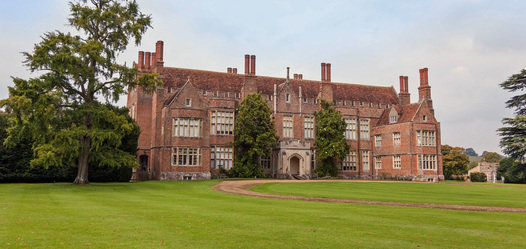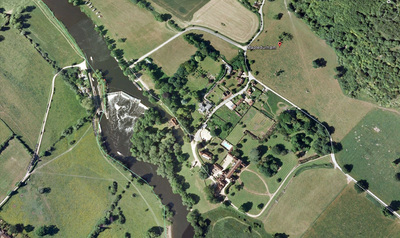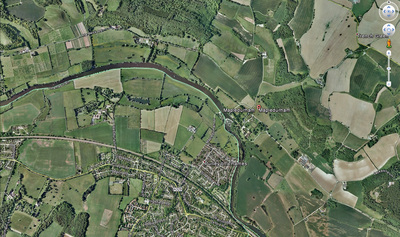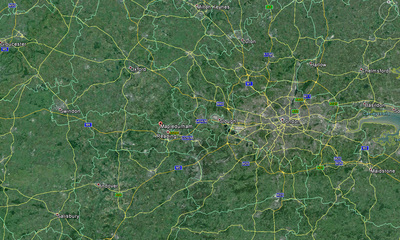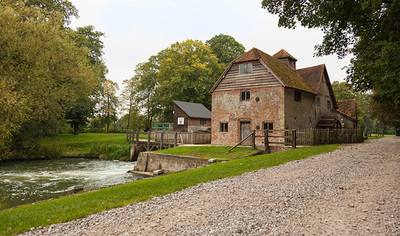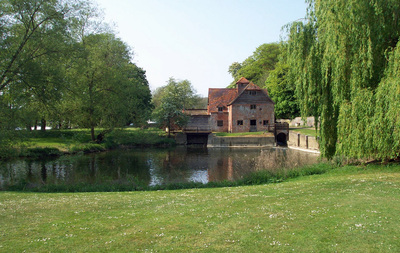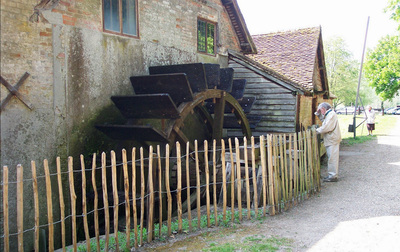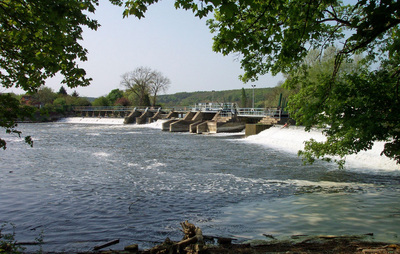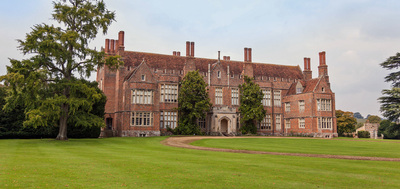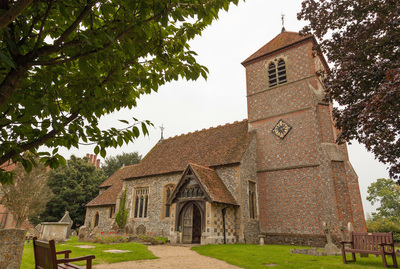Author: Keith Millard
Introduction:
This is a story about a truly remarkable place... and the birthplace of the Miller/Millar/Millurd/Millard/Millarde family that lived there, and were the ancestors of many Millards in many countries today. The family will be written about in a separate essay (or more than one). Suffice it to say, the owners and workers at the mill were likely given the surname of Myllward in the 1300s when a poll tax was introduced, requiring all Englishmen to be given a surname, and it is unlikely all these men were biologically related.
This essay is about the picturesque village of Mapledurham today, and its origins and history.
Mapledurham today is a small village, civil parish, and country estate beside the River Thames in southern Oxfordshire (formerly part of Berkshire). The village is on the north bank of the River Thames about 3.5 miles (5.6 km) northwest of the town of Reading. The only road access is by a narrow and steep lane from Trench Green on the road between Caversham and Goring-on-Thames. Despite the fact that Mapledurham village is closer, as the crow flies, to central Reading than some of that town's suburbs, it remains a remote and rural location.
The Church of St. Margaret is mainly 14th and 15th century, and was restored in 1863. The Mapledurham Watermill is 16th and 17th century and is the last operational watermill on the Thames. Mapledurham House, the country house that is the headquarters of the Mapledurham estate, is one of the largest Elizabethan houses in Oxfordshire.
Mapledurham Lock is on the opposite bank of the river, by the Berkshire village of Purley-on-Thames. Although the weir stretches across the river between the two villages, no access is possible across it and, in the absence of a boat, journeys between the two villages require a lengthy detour via Caversham or Whitchurch-on-Thames.
Because of its picturesque situation, and lack of through traffic, Mapledurham has been used as a set for several films, most notably the 1976 film The Eagle has Landed. The village, house and mill form something of a local tourist attraction, and on summer weekends the village can be reached by a boat service from Reading. The Mapledurham estate owns much of the village and parish. It also includes the Mapledurham Watermill, a historic and still operational watermill on the River Thames, and Mapledurham House an Elizabethan stately home.
Click on photos to enlarge, cursor over to see caption:
Introduction:
This is a story about a truly remarkable place... and the birthplace of the Miller/Millar/Millurd/Millard/Millarde family that lived there, and were the ancestors of many Millards in many countries today. The family will be written about in a separate essay (or more than one). Suffice it to say, the owners and workers at the mill were likely given the surname of Myllward in the 1300s when a poll tax was introduced, requiring all Englishmen to be given a surname, and it is unlikely all these men were biologically related.
This essay is about the picturesque village of Mapledurham today, and its origins and history.
Mapledurham today is a small village, civil parish, and country estate beside the River Thames in southern Oxfordshire (formerly part of Berkshire). The village is on the north bank of the River Thames about 3.5 miles (5.6 km) northwest of the town of Reading. The only road access is by a narrow and steep lane from Trench Green on the road between Caversham and Goring-on-Thames. Despite the fact that Mapledurham village is closer, as the crow flies, to central Reading than some of that town's suburbs, it remains a remote and rural location.
The Church of St. Margaret is mainly 14th and 15th century, and was restored in 1863. The Mapledurham Watermill is 16th and 17th century and is the last operational watermill on the Thames. Mapledurham House, the country house that is the headquarters of the Mapledurham estate, is one of the largest Elizabethan houses in Oxfordshire.
Mapledurham Lock is on the opposite bank of the river, by the Berkshire village of Purley-on-Thames. Although the weir stretches across the river between the two villages, no access is possible across it and, in the absence of a boat, journeys between the two villages require a lengthy detour via Caversham or Whitchurch-on-Thames.
Because of its picturesque situation, and lack of through traffic, Mapledurham has been used as a set for several films, most notably the 1976 film The Eagle has Landed. The village, house and mill form something of a local tourist attraction, and on summer weekends the village can be reached by a boat service from Reading. The Mapledurham estate owns much of the village and parish. It also includes the Mapledurham Watermill, a historic and still operational watermill on the River Thames, and Mapledurham House an Elizabethan stately home.
Click on photos to enlarge, cursor over to see caption:
Mapledurham origins and history:
A mill was already present at Mapledurham at the time of the Domesday Book (a manuscript that records the great survey of much of England and parts of Wales completed in 1086). The survey was executed for William the Conqueror. The central section of the current mill building dates back to the 15th century. Originally the mill had a single water wheel, on the river side of the building. The mill was increased in size in the 1670s, and a leat was constructed to drive a second water wheel on the village side. It is this second wheel which is still in use today.
The property was first held by Sir Michael Blount (c. 1530–1610), he was a Tudor and Jacobean royal official and politician. He was born in Mapledurham House to Sir Richard Blount (1505–1564); he was High Sheriff of Buckinghamshire in 1576, then of Oxfordshire in 1586 and 1597. He was elected the Member of Parliament for Winchelsea in March 1553 and Marlborough in 1563. He became Lieutenant of the Tower of London in 1590 and held the post for five years until 1595, in December of which year he was briefly imprisoned in the Tower himself.
The property has remained with the family for 400 years. It was built at the time of the Spanish Armada in the classic Elizabethan E-shape. It includes a late 18th century chapel built in the Strawberry Hill Gothic style for the Catholic owners of the house at that time. The estate covers much of the village including Mapledurham Watermill and part of the St Margaret's Church.
The church continued being Catholic after Henry VIII banned the Catholic church in the 1500s, but escaped scrutiny due to its isolation, though it did have a priesthole in the event the King's Men showed up. Parish records were destroyed and the church damaged in the mid 1600s when attacked by Oliver Cromwell's Roundheads.
The first recorded Millard was Richard Millarde, born in Mapledurham circa 1630, and the oldest known ancestor of the Mapledurham Millards. He has 291 descendants and over 5,000 blood relatives in the Geni Family Tree.
A mill was already present at Mapledurham at the time of the Domesday Book (a manuscript that records the great survey of much of England and parts of Wales completed in 1086). The survey was executed for William the Conqueror. The central section of the current mill building dates back to the 15th century. Originally the mill had a single water wheel, on the river side of the building. The mill was increased in size in the 1670s, and a leat was constructed to drive a second water wheel on the village side. It is this second wheel which is still in use today.
The property was first held by Sir Michael Blount (c. 1530–1610), he was a Tudor and Jacobean royal official and politician. He was born in Mapledurham House to Sir Richard Blount (1505–1564); he was High Sheriff of Buckinghamshire in 1576, then of Oxfordshire in 1586 and 1597. He was elected the Member of Parliament for Winchelsea in March 1553 and Marlborough in 1563. He became Lieutenant of the Tower of London in 1590 and held the post for five years until 1595, in December of which year he was briefly imprisoned in the Tower himself.
The property has remained with the family for 400 years. It was built at the time of the Spanish Armada in the classic Elizabethan E-shape. It includes a late 18th century chapel built in the Strawberry Hill Gothic style for the Catholic owners of the house at that time. The estate covers much of the village including Mapledurham Watermill and part of the St Margaret's Church.
The church continued being Catholic after Henry VIII banned the Catholic church in the 1500s, but escaped scrutiny due to its isolation, though it did have a priesthole in the event the King's Men showed up. Parish records were destroyed and the church damaged in the mid 1600s when attacked by Oliver Cromwell's Roundheads.
The first recorded Millard was Richard Millarde, born in Mapledurham circa 1630, and the oldest known ancestor of the Mapledurham Millards. He has 291 descendants and over 5,000 blood relatives in the Geni Family Tree.
